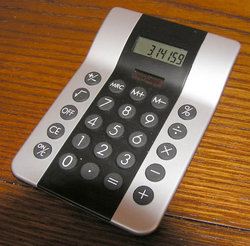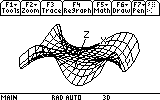Calculator -Hand Held Electronic

A calculator is a device for performing numerical calculations. It should not be confused with a calculating machine. Nowadays many people have a calculator with them as part of their mobile phone and/or personal digital assistant. Engineers and accountants make use of calculators for problems where a computation is not complex enough to demand the use of a general-purpose computer. Students use calculators for schoolwork. Also, some wrist watches contain a calculator (although this was more a fad of the 1980s).
Overview
Today calculators are electrically powered, most often by battery, and are made by numerous manufacturers, in countless shapes and sizes varying from cheap, give-away, credit-card sized models to more sturdy adding machine-like models with built-in printers. Only a very few companies develop and make modern professional engineering and finance calculators; the most well-known are Casio, Hewlett-Packard (HP) and Texas Instruments (TI). Such calculators are good examples of embedded systems.
In the near past, mechanical and clerical aids such as abaci, comptometers, Napier's bones, books of mathematical tables, slide rules, adding machines, were used for serious numeric work, and the word "calculator" denoted a person (most often male) who did such work for a living using such aids as well as pen and paper. This semi-manual process of calculation was tedious and error-prone.
Today most calculators are handheld microelectronic devices, but in the past some calculators were as large as today's computers. The first mechanical calculators were mechanical desktop devices, which were soon replaced by electromechanical desktop calculators, and then by electronic devices using first thermionic valves, then transistors, then hard-wired integrated circuit logic.
A pocket calculator is a small battery-powered or solar powered electronic digital computer made possible by integrated circuit and semiconductor technology. Typically they are limited to an 8–10 digit single-number display and a few basic functions of arithmetic, but some modern ones have more of the features of a general-purpose computer. Pocket calculators rendered the slide rule obsolete.
Calculators vary in their capabilities. Some are limited to only basic arithmetic; others support trigonometric and other mathematical functions. The most advanced modern calculators are programmable, can display graphics, and include features of computer algebra systems.
History
One of the first calculators was Pascal's calculator invented in 1645. This was used for taxes in France until 1799. Later on in 1954, IBM demonstrated a large all-transistor calculator. In 1957, IBM released the first commercial all-transistor calculator (the IBM 608). The first handheld calculators, as opposed to desktop ones, went on sale in 1970 with models from Japanese manufacturers Sharp and Canon weighing around 1.7 lb (770 g).
1970s to mid-1980s
The first pocket-sized calculator, the Bowmar 901B measuring 5.2×3.0×1.5 in (131×77×37 mm), came out in the fall of 1971, with four functions and an eight-digit red LED display, for $240, while in August 1972 the four-function Sinclair Executive became the first slimline pocket calculator measuring 5.4×2.2×0.35 in (138×56×9 mm) and weighing 2.5 oz (70g). It retailed for around $150 (GB£79). By the end of the decade, similar calculators were priced less than $10 (GB£5).
The first pocket calculator with scientific functions, i.e. the first slide rule-replacing model, was the 1972 HP-35 from Hewlett Packard (HP); it, along with all later HP engineering calculators, used reverse Polish notation (RPN) (where a calculation like "6 – 2" is performed by pressing "6", "Enter!‘", "2", and "–"; instead of algebraically: "6", "–", "2", "=").
Most common among early scientific calculators was the TI-30 from Texas Instruments (TI). The first programmable hand-held calculator was the HP-65, in 1974; it had a capacity of 100 instructions, and could store and retrieve programs with a built-in magnetic card reader. A year later the HP-25C introduced continuous memory, i.e. programs and data were retained in memory during power-off. In 1979, HP released the first alphanumeric, programmable, expandable calculator, the HP-41C. It could be expanded with RAM (memory) and ROM (software) modules, as well as peripherals like bar code wands, cassette tape and floppy disk drives, paper-roll printers, and miscellaneous communication interfaces (RS-232, HP-IL, HP-IB).
Mid-1980s to date
The two leading manufacturers, HP and TI, released steadily more feature-laden calculators during the 1980s and 90s. At the turn of the millennium, the line between a graphing calculator and a PDA/ handheld computer was not always clear (forgetting the keyboard for the sake of the argument), as some very advanced calculators such as the TI-89 and HP-49G could differentiate and integrate functions, run word processing and PIM software, and connect by wire or IR to other calculators/computers.
In March 2002, HP announced that the company would no longer produce calculators, which was hard to fathom for some fans of the company's products; the HP-48 range in particular had an extremely loyal customer base. Nevertheless, HP restarted their production of calculators in late 2003. The new models, however, reportedly didn't have the mechanical quality and sober design HP's earlier calculators were famous for (instead featuring the more "youthful" look and feel of contemporary competing designs from TI).
The business calculator HP-12C is still produced. It was introduced in 1981 and is still being made with nearly no changes. In 2003 several new models were released, including an improved version of the HP-12C, the "HP-12C platinum edition".
Trivia
- The word "calculator" is occasionally used as a pejorative term to describe an inadequately capable general-purpose microcomputer. The synonym of this meaning is "bitty box", as discussed in the Jargon file.
- A curious episode of the mid 1970s involved the Melcor 635, a scientific calculator with a bug in its trigonometric functions. Because the CORDIC algorithms used in most calculators cannot compute the inverse functions of zero, these need to be hardcoded —and some engineer at Melcor got it wrong. For any input other than exactly zero, even for instance 1.0E-99, the calculator worked correctly; the user simply had to remember not to compute the arc-cosine of zero. The company discovered this after making 50,000 calculators. The upshot was an advertisement in Scientific American headlined 'Somebody Goofed', offering these calculators for sale at half-price.
- As many schoolchildren and students know, some words and simple phrases can be written using an ordinary seven-segment display calculator; this involves entering certain numbers and then viewing the resulting words from the opposite side of the calculator display. Typical words/phrases obtainable in this fashion are (some of them, not surprisingly, quite representative of the demographic in question):
See also
General interest:
Mechanical calculators:
Electronic calculators:
Patents
- U.S. Patent 2668661 -- Complex computer -- G. R. Stibitz (electromachanic device that would calculate, record, and print results)
- U.S. Patent 3819921 -- Miniature electronic calculator -- J. S. Kilby (TI electromachanic device)
External links
- Online Calculator Software (http://web.peoriadesignweb.com/calculator)
- Scientific Calculator (http://ostermiller.org/calc/calculator.html) - Scientific notation, hex, octal, decimal, binary, and math functions. Requires JavaScript. (from ostermiller.org)
- The Old Calculator Web Museum (http://www.oldcalculatormuseum.com)
- Calculator Museum (http://www.calculators.de)
- Museum of Soviet Calculators (http://www.taswegian.com/MOSCOW/soviet.html)
- Soviet Calculators Collection (http://www.rk86.com/frolov/calcolle.htm)
- Vintage Calculators (http://www.vintagecalculators.com/index.html)
- various calculators (http://www.lendingok.com)
- Broken Calculator (http://www.cut-the-knot.org/Curriculum/Arithmetic/BrokenCalculator.shtml)
- GraphCalc – an Open Source graphing calculator program (http://www.graphcalc.com)
- HiDigit scientific calculator (http://www.binarythings.com/hidigit/)
- The Museum of HP Calculators (http://www.hpmuseum.org) (slide rules/mech. section (http://www.hpmuseum.org/prehp.htm))
- HP Calculator Wiki (http://www.hydrix.com/wiki/)
- On TI's US Patent No. 3,819,921 (http://www.ti.com/corp/docs/company/history/calc.shtml)
- Library of online calculators (http://www.mortgage-loan-solutions.com/calculators.htm)

